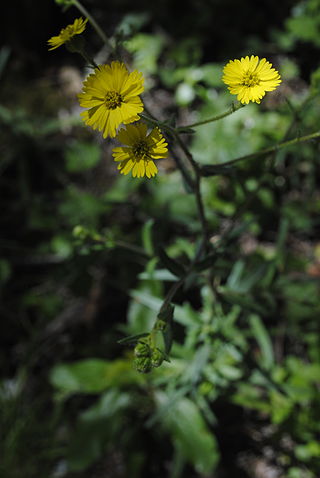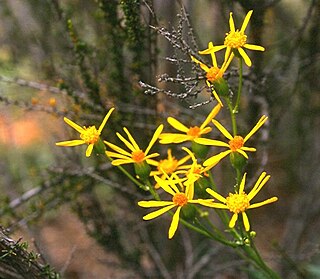
Hooveria purpurea is a species of flowering plant related to the agaves known by the common name purple amole. This species of soap plant is endemic to California, where it grows in the Santa Lucia Range, in the Central Coast region. There are two varieties of this plant, and both are believed to be quite rare. It is a federally listed threatened species.

Arctostaphylos myrtifolia is a rare species of manzanita known by the common name Ione manzanita. It is endemic to the Sierra Nevada foothills of California. It grows in the chaparral and woodland plant community on a distinctive acidic soil series, an oxisol of the Eocene-era Ione Formation, in western Amador and northern Calaveras counties. There are only eleven occurrences, of which three have not been recorded since 1976. This is a federally listed threatened species.
Astragalus pauperculus is an uncommon species of milkvetch known by the common name depauperate milkvetch. It is endemic to northern California, where it is known from the northern Sacramento Valley and the lowest reaches of the Cascade foothills adjacent. It grows in chaparral and vernally wet grassland habitat. This is a very small annual milkvetch which grows in a delicate mat with stems no longer than 10 cm (3.9 in). The leaves are a few centimeters long and are made up of small widely spaced leaflets. The inflorescence bears two to seven flowers which are purple, sometimes with paler colored edges on their petals. Each flower is generally less than 1 cm (0.39 in) long. The fruit is a crescent-shaped legume pod between 1 and 2 cm long.

Ceanothus roderickii is a rare species of shrub in the family Rhamnaceae known by the common name Pine Hill ceanothus. It is endemic to western El Dorado County, California, where it grows in the chaparral and woodlands of the Sierra Nevada foothills, such as the Pine Hill Ecological Reserve. It is named after 20th century California flora explorer, botanist, and arboretum director Wayne Roderick.
Eryngium pinnatisectum is an uncommon species of flowering plant in the family Apiaceae, known by the common names Tuolumne eryngo and Tuolumne button celery.
Eryngium racemosum is a rare species of flowering plant in the family Apiaceae known by the common name delta eryngo, or delta button celery.

Anisocarpus madioides is a North American species of flowering plant in the family Asteraceae known by the common name woodland madia.

Paronychia ahartii is a species of flowering plant in the family Caryophyllaceae known by the common name Ahart's nailwort. It is endemic to California, where it is known from three counties at the northern edge of the Sacramento Valley where it rises into the southern slopes of the Cascade Range. It is a plant of moist, rocky habitat, such as vernal pools. This is a petite plant producing a nearly invisible stem from a threadlike taproot. The plant is only about a centimeter wide and somewhat spherical in shape. It is a tiny patch of bristle-tipped green leaves a few millimeters in length with oval-shaped stipules. The single flower occurring in each leaf axil has no petals but white, rough-textured, awn-tipped sepals clustered around the leaves.
Polygonum bidwelliae is an uncommon species of flowering plant in the knotweed family known by the common name Bidwell's knotweed. The plant was named for American suffragist Annie Bidwell, who at one time lived in the Bidwell Mansion in Chico, California. She is the person who collected the type specimen in Northern California.
Pseudobahia bahiifolia is a rare species of flowering plant in the family Asteraceae known by the common name Hartweg's golden sunburst.
Pseudobahia peirsonii is a rare species of flowering plant in the family Asteraceae known by the common names San Joaquin adobe sunburst and Tulare pseudobahia. It is endemic to California, where it is known from a few mostly small occurrences along the southeastern side of the San Joaquin Valley where it rises into the Sierra Nevada foothills. It grows in grassland and oak woodland habitat. It prefers heavy adobe clay soils. The plant became a federally listed threatened of the United States in 1997.
Ranunculus canus is a species of buttercup known by the common name Sacramento Valley buttercup. It is endemic to California, where it grows in the Central Valley and adjacent mountain foothills, and the Transverse Ranges just south. It grows in grassland and meadows in woodland and forest habitat. This plant can be very similar in appearance to the California buttercup, and may be difficult to distinguish from it. It is variable in form. In general the plant is a perennial herb producing erect, usually hairy stems up to 65 centimeters tall. The hairy leaves are each made up of three leaflets, leaves occurring lower on the plant with wider leaflets which may be notched to lobed, and upper leaves with narrow, toothed leaflets. The flower has up to 23 shiny yellow petals and many yellow stamens and pistils at the center. The fruit is an achene, borne in a spherical cluster of 11 or more.

Packera layneae, known by the common name Layne's ragwort and Layne's butterweed, is a rare species of flowering plant in the aster family.

Sidalcea keckii is a rare species of flowering plant in the mallow family, known by the common names Keck's checkerbloom and Keck's checkermallow.

Sidalcea stipularis is a rare species of flowering plant in the mallow family, known by the common name Scadden Flat checkerbloom.

Streptanthus longisiliquus is a species of flowering plant in the mustard family known by the common name long-fruit jewelflower. It was first described to science in 2007. It is endemic to northern California, where it is known from Butte, Tehama, and Shasta Counties. It can be found in forest and woodland habitat in mountains and foothills. It is a short-lived perennial herb producing a few-branched stem up to 1.2 to 1.5 meters in maximum height. It is mostly hairless except for some light hairs on the inflorescences and sometimes the leaf petioles. The basal leaves have oval or spoon-shaped blades up to 10 centimeters long, usually with smooth edges. Leaves higher on the stem are oval or oblong and lack petioles, their bases often clasping the stem. Flowers occur at intervals along the upper stem. Each flower has a bell-shaped calyx of sepals which yellow-green at the base and purplish at the tip, measuring under a centimeter in length. The petals emerging from the end are brownish or purplish with greenish bases. The fruit is a flattened, curving silique that can be quite long even for the genus, measuring up to 15 centimeters in length.
Trichostema rubisepalum is a species of flowering plant in the mint family known by the common name Hernandez's bluecurls.

Agnorhiza reticulata, known by the common name El Dorado County mule's ears, is a rare species of flowering plant found only in a small region of north-central California.
Juncus digitatus is a rare species of rush known by the common name finger rush. It is endemic to Shasta County, California, where it is known from only two occurrences near Shingletown. It occurs in spring-moist habitat such as vernal pools in sunny locations in the foothills of the southernmost Cascade Range. The plant was first collected in 1991 and described to science as a new species in 2008.

Calochortus coxii is a rare species of flowering plant in the lily family known by the common names Cox's mariposa lily and crinite mariposa lily. It is endemic to Oregon in the United States, where it is known only from Douglas County.











